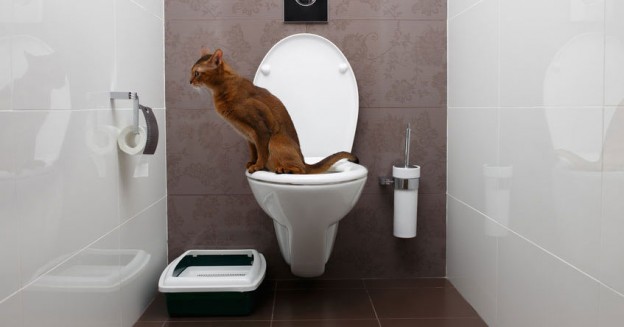Prevent Plumbing Problems: Never Flush Cat Poop Down Your Toilet - Professional Advice
Prevent Plumbing Problems: Never Flush Cat Poop Down Your Toilet - Professional Advice
Blog Article
Are you currently in search of guidance concerning Can You Flush Cat Poo or Litter Down the Toilet??

Intro
As feline proprietors, it's important to be mindful of how we throw away our feline pals' waste. While it may seem hassle-free to flush cat poop down the bathroom, this technique can have detrimental effects for both the environment and human health and wellness.
Environmental Impact
Flushing pet cat poop introduces damaging pathogens and parasites right into the water, presenting a considerable danger to aquatic ecological communities. These contaminants can negatively influence marine life and concession water top quality.
Health and wellness Risks
Along with ecological issues, flushing cat waste can also present wellness dangers to human beings. Cat feces may include Toxoplasma gondii, a bloodsucker that can create toxoplasmosis-- a possibly extreme health problem, especially for expecting women and people with damaged body immune systems.
Alternatives to Flushing
Thankfully, there are much safer and more accountable methods to throw away cat poop. Take into consideration the adhering to alternatives:
1. Scoop and Dispose in Trash
The most typical technique of taking care of feline poop is to scoop it into a naturally degradable bag and toss it in the trash. Be sure to make use of a specialized clutter inside story and throw away the waste without delay.
2. Use Biodegradable Litter
Opt for biodegradable pet cat trash made from materials such as corn or wheat. These trashes are eco-friendly and can be safely taken care of in the trash.
3. Bury in the Yard
If you have a yard, think about burying pet cat waste in a designated area far from veggie gardens and water sources. Make certain to dig deep enough to stop contamination of groundwater.
4. Install a Pet Waste Disposal System
Purchase a family pet waste disposal system specifically developed for cat waste. These systems use enzymes to break down the waste, reducing smell and environmental impact.
Conclusion
Liable animal possession expands past offering food and shelter-- it likewise entails appropriate waste administration. By avoiding flushing cat poop down the commode and choosing alternative disposal techniques, we can lessen our ecological impact and safeguard human health.
Why Can’t I Flush Cat Poop?
It Spreads a Parasite
Cats are frequently infected with a parasite called toxoplasma gondii. The parasite causes an infection called toxoplasmosis. It is usually harmless to cats. The parasite only uses cat poop as a host for its eggs. Otherwise, the cat’s immune system usually keeps the infection at low enough levels to maintain its own health. But it does not stop the develop of eggs. These eggs are tiny and surprisingly tough. They may survive for a year before they begin to grow. But that’s the problem.
Our wastewater system is not designed to deal with toxoplasmosis eggs. Instead, most eggs will flush from your toilet into sewers and wastewater management plants. After the sewage is treated for many other harmful things in it, it is typically released into local rivers, lakes, or oceans. Here, the toxoplasmosis eggs can find new hosts, including starfish, crabs, otters, and many other wildlife. For many, this is a significant risk to their health. Toxoplasmosis can also end up infecting water sources that are important for agriculture, which means our deer, pigs, and sheep can get infected too.
Is There Risk to Humans?
There can be a risk to human life from flushing cat poop down the toilet. If you do so, the parasites from your cat’s poop can end up in shellfish, game animals, or livestock. If this meat is then served raw or undercooked, the people who eat it can get sick.
In fact, according to the CDC, 40 million people in the United States are infected with toxoplasma gondii. They get it from exposure to infected seafood, or from some kind of cat poop contamination, like drinking from a stream that is contaminated or touching anything that has come into contact with cat poop. That includes just cleaning a cat litter box.
Most people who get infected with these parasites will not develop any symptoms. However, for pregnant women or for those with compromised immune systems, the parasite can cause severe health problems.
How to Handle Cat Poop
The best way to handle cat poop is actually to clean the box more often. The eggs that the parasite sheds will not become active until one to five days after the cat poops. That means that if you clean daily, you’re much less likely to come into direct contact with infectious eggs.
That said, always dispose of cat poop in the garbage and not down the toilet. Wash your hands before and after you clean the litter box, and bring the bag of poop right outside to your garbage bins.
https://trenchlesssolutionsusa.com/why-cant-i-flush-cat-poop/

We are very eager about How to Dispose of Cat Poop and Litter Without Plastic Bags and I'm hoping you enjoyed the page. Please take the time to promote this write-up if you appreciated it. I take joy in reading our article about Don’t flush cat feces down the toilet.
Click Here Report this page